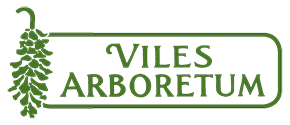Visitors to Viles Arboretum the week of Nov. 14 (2010) might make the following observations:
From a distance and in the right light, you might be fooled into thinking that forsythias is in flower again along some of the pathways here at Viles Arboretum.
 Upon closer approach, the yellow color proves to be leaves, not flowers, and the plants themselves turn out to be shrubby honeysuckle (not to be confused with our native native honeysuckle species). The shape and form of this abundant and unkempt looking shrub is indeed similar to forsythia and the two species do grow in close proximity to one another along the Hosta Trail and near the Quarry Ledge Rock Garden. Forsythia, of course, finished flowering back in May and has been bare of leaves for several weeks. In contrast, some shrubby honeysuckle leaves are still green and even most of the yellow ones still cling tightly to the twigs.
Upon closer approach, the yellow color proves to be leaves, not flowers, and the plants themselves turn out to be shrubby honeysuckle (not to be confused with our native native honeysuckle species). The shape and form of this abundant and unkempt looking shrub is indeed similar to forsythia and the two species do grow in close proximity to one another along the Hosta Trail and near the Quarry Ledge Rock Garden. Forsythia, of course, finished flowering back in May and has been bare of leaves for several weeks. In contrast, some shrubby honeysuckle leaves are still green and even most of the yellow ones still cling tightly to the twigs.
While neither forsythia nor honeysuckles are native to Maine, the former is an old fashioned favorite and relatively well-behaved shrub that is used in landscaping and home gardens. The latter - though less well-known and seldom intentionally planted - is far more abundant.
Forsythia tends to stay pretty much where it is planted, but shrubby honeysuckle is considered to be invasive; it spreads readily, rapidly and abundantly. Like many of the invasive plants at the arboretum, shrubby honeysuckle produces fruit that is highly attractive to birds, especially robins, catbirds and waxwings. These and other species relish the juicy berries, but the seeds pass through the birds undigested. They soon emerge wrapped in their own little fertilizer packets. The birds inadvertently plant them from their favorite perches - which is one reason you find shrubby honeysuckle (and other invasive fruiting shrubs) along field-forest edges and open pathways.
Why shrubby honeysuckle is one of the last of the deciduous shrubs to drop its leaves is a mystery. What makes it even more interesting is it is also one of the first woody plants to leaf out in the spring. Perhaps it gains some of it aggressive edge by extending its growing season by several weeks over the native plants with which it competes for space and sunlight. Or, perhaps, it is simply a sign the plant is growing outside of its native habitat and its internal biorhythms have not yet adapted to Maine's different climate and growing season.
What we call shrubby honeysuckle is actually a complex of related species native to Asia and ranging from central Russia to Japan. For many years, and as recently as the 1970's, it was promoted by conservation agencies as a wildlife food plant. It certainly is that, but like many well-intentioned ideas involving transplanting a species outside of its native range, it succeeded all too well.
It is probably not just a coincidence that many of the woody plants at the arboretum that stay green well into the fall are native to places other than Maine. While our deciduous trees are mostly bare (or brown) by mid-November, Norway maple, autumn olive, and common buckthorn are readily apparent in their green and yellow hues. Like shrubby honeysuckle, these plants originated on other continents and were planted in North America with the best of intentions.
A week of warm temperatures, arriving after hard frosts and several weeks of cold nights, is sometimes called "Indian Summer". Perhaps, with the soaking rains and wet ground that accompanied the warm-up, "second spring" might be more appropriate.
With the soil still warm and porous, the rain penetrated deeply and some creatures that thought the had settled in for the winter found they needed to seek refuge above ground until things dried out a little. Fortunately, clear skies allowed the weak November sun to warm things up and dry them out.
Normally dormant at this time of the year, a large garter snake took advantage of a south-facing knoll in the Urban and Community Forestry Collection and spent most of a day sunning quietly, its mud-streaked scales telling its tale of a flooded winter burrow. By late afternoon the snake had sluggishly retreated to its (hopefully) drier quarters.
Even some of the native trees were fooled by the warm weather. During a weekend pruning demonstration and workshop, sap practically gushed from a young maple when a small branch was sheared off. Normally the tree, like the snake, would be dormant at this time and we would not expect its sap to be flowing. Sap flow can occur at any time if conditions are right, but it's probably a bit early to break out the sap buckets just yet.
Snakes and sap were not the only surprises at the arboretum during this late autumn warm spell. Daisy-like chrysanthemums were still flowering in the Quarry Ledge Rock Garden and, unless winter puts in an appearance soon, may remain in bloom until December. So, if you are one of the few people who are not yet yearning for snow, you can still enjoy a little lingering taste of summer there and perhaps be one of the first visitors to take advantage of the new stone bench.
Stephen Oliveri, Thursday, November 18, 2010

